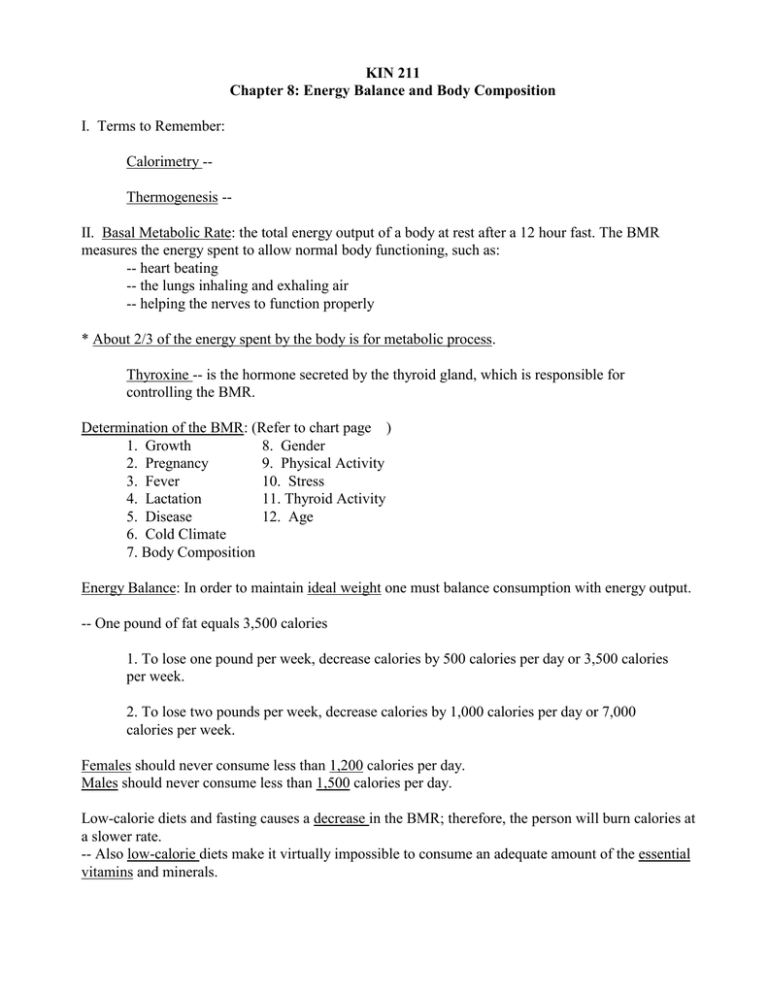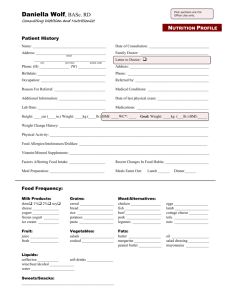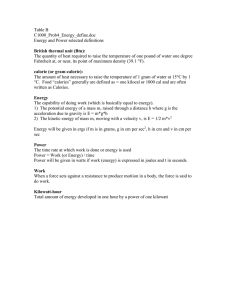KIN 211 Chapter 8: Energy Balance and Body Composition
advertisement

KIN 211 Chapter 8: Energy Balance and Body Composition I. Terms to Remember: Calorimetry -Thermogenesis -II. Basal Metabolic Rate: the total energy output of a body at rest after a 12 hour fast. The BMR measures the energy spent to allow normal body functioning, such as: -- heart beating -- the lungs inhaling and exhaling air -- helping the nerves to function properly * About 2/3 of the energy spent by the body is for metabolic process. Thyroxine -- is the hormone secreted by the thyroid gland, which is responsible for controlling the BMR. Determination of the BMR: (Refer to chart page ) 1. Growth 8. Gender 2. Pregnancy 9. Physical Activity 3. Fever 10. Stress 4. Lactation 11. Thyroid Activity 5. Disease 12. Age 6. Cold Climate 7. Body Composition Energy Balance: In order to maintain ideal weight one must balance consumption with energy output. -- One pound of fat equals 3,500 calories 1. To lose one pound per week, decrease calories by 500 calories per day or 3,500 calories per week. 2. To lose two pounds per week, decrease calories by 1,000 calories per day or 7,000 calories per week. Females should never consume less than 1,200 calories per day. Males should never consume less than 1,500 calories per day. Low-calorie diets and fasting causes a decrease in the BMR; therefore, the person will burn calories at a slower rate. -- Also low-calorie diets make it virtually impossible to consume an adequate amount of the essential vitamins and minerals. Determining your ideal weight is a very difficult task because each person is so different and so many factors must be considered, such as: -- gender -- age -- height -- bone frame -- body consumption In the past we relied on height/weight charts published by companies like Metropolitan Life Ins. -- These charts do not consider all of the factors. A person’s body composition is an important factor to consider in determining ideal wieght and proper health. Muscle weighs more than fat. Determining Ideal Weight Step 1 - Males- 106 pounds for first 5 ft. in height. Add 6 pounds for each add. inch. - Females- 100 pounds for first 5 ft in height. Add 5 pounds for each add. inch. Step 2 - Bone frame Size -- Small- subtract 10% Medium- remain the same Large- add 10% ** Hand-out tape measures and let students determine frame size. Refer to handout. Step 3 - Body Composition -- Average percentages of body fat: Male: 13-19% (5-10% minimum) Female: 18-25% (12-15% minimum) Health risks begin to develop when body fat exceeds: - 22%- younger men - 25%- older men - 32%- younger women - 35%- older women Ideal body weight is defined by specific criteria: - a weight within the suggested range for height, as shown on a height/weight table. - a fat distributing pattern that is associated with low risk of illness and death. - freedom from all medical conditions that would suggest a need for weight loss. Using Body Mass Index to calculate ideal weight-Modified equations: BMI < 20 = underweight BMI 20-25 = normal BMI 25-30 = overweight BMI > 30 = obese Body Fat Distribution: (Central Obesity) Several studies have concluded that excessive abdominal fat is associated with a higher risk of heart disease, stroke, diabetes, hypertension




